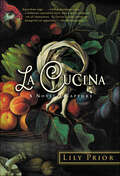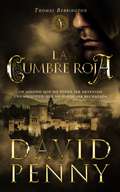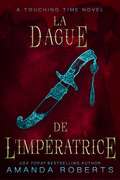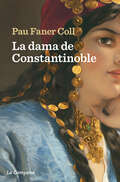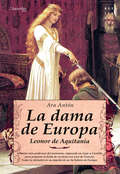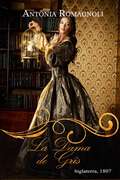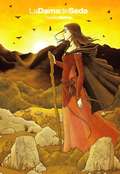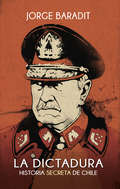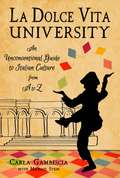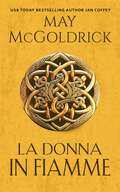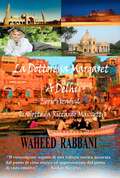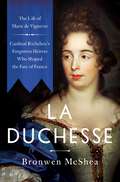- Table View
- List View
La Cucina: A Novel of Rapture
by Lily PriorSince childhood, Rosa Fiore -- daughter of a sultry Sicilian matriarch and her hapless husband -- found solace in her family's kitchen. La Cucina, the heart of the family's lush estate, was a place where generations of Fiore women prepared sumptuous feasts and where the drama of extended family life was played out around the age-old table.When Rosa was a teenager, her own cooking became the stuff of legend in this small community that takes pride in the bounty of its landscape and the eccentricity of its inhabitants. Rosa's infatuation with culinary arts was rivaled only by her passion for a young man, Bartolomeo, who, unfortunately, belonged to another. After their love affair ended in tragedy, Rosa retreated first into her kitchen and then into solitude, as a librarian in Palermo. There she stayed for decades, growing corpulent on her succulent dishes, resigned to a loveless life.Then, one day, she meets the mysterious chef, known only is I'Inglese, whose research on the heritage of Sicilian cuisine leads him to Rosa's library, and into her heart. They share one sublime summer of discovery, during which I'lnglese awakens the power of Rosa's sensuality, and together they reach new heights of culinary passion. When I'Inglese suddenly vanishes, Rosa returns home to the farm to grieve for the loss of her second love. In the comfort of familiar surroundings, among her, growing family, she discovers the truth about her loved ones and finds her life transformed once more by the magic of her cherished Cucina.Exuberant and touching, La Cucina is a magical evocation of lifes mysterious seasons and the treasures found in each one. It celebrates family, food, passion, and the eternal rapture of romance.
La Cuisine Creole
by Lafcadio HearnPublished in New Orleans in 1885, one of the great classics of Creole cuisine, believed to be the first Creole cookbook in print.Although La Cuisine Creole was printed anonymously in 1885, Lafcadio Hearn is generally accepted as the author of this Creole culinary classic. In his introduction, Hearn describes the intriguing origin of this unique cuisine, explaining that, “it partakes of the nature of its birthplace—New Orleans—which is cosmopolitan in its nature, blending the characteristics of the American, French, Spanish, Italian, West Indian and Mexican . . . There are also obvious influences from Native Americans, African Americans, and others in the American melting pot.” Among the “many original recipes and other valuable ones heretofore unpublished” included in the book are Gombo file, Bouille-abaisse, Courtbouillon, Jambolaya, Salade a la Russe, Bisque of Gray-fish a la Creole, Pousse Café, Café brule, Okra Gombo, Grenouilles Frites, Pain Perdu, Sangaree, and a marvelous collection of fish, seafood, and game recipes. There are also instructions on “The Service of Wine” and a large number of recipes for drinks and cocktails. This edition of La Cuisine Creole by Lafcadio Hearn was reproduced by permission from the volume in the collection of the American Antiquarian Society, Worcester, Massachusetts, founded in 1812.
La Cuisine Creole: A Collection Of Culinary Recipes, From Leading Chefs And Noted Creole House Wises, Who Have Made New Orleans Famous For Its Cuisine (classic Reprint)
by Lafcadio HearnPublished in New Orleans in 1885, one of the great classics of Creole cuisine, believed to be the first Creole cookbook in print.Although La Cuisine Creole was printed anonymously in 1885, Lafcadio Hearn is generally accepted as the author of this Creole culinary classic. In his introduction, Hearn describes the intriguing origin of this unique cuisine, explaining that, “it partakes of the nature of its birthplace—New Orleans—which is cosmopolitan in its nature, blending the characteristics of the American, French, Spanish, Italian, West Indian and Mexican . . . There are also obvious influences from Native Americans, African Americans, and others in the American melting pot.” Among the “many original recipes and other valuable ones heretofore unpublished” included in the book are Gombo file, Bouille-abaisse, Courtbouillon, Jambolaya, Salade a la Russe, Bisque of Gray-fish a la Creole, Pousse Café, Café brule, Okra Gombo, Grenouilles Frites, Pain Perdu, Sangaree, and a marvelous collection of fish, seafood, and game recipes. There are also instructions on “The Service of Wine” and a large number of recipes for drinks and cocktails. This edition of La Cuisine Creole by Lafcadio Hearn was reproduced by permission from the volume in the collection of the American Antiquarian Society, Worcester, Massachusetts, founded in 1812.
La Cumbre Roja
by David Penny David E. MartínezUn asesino que no puede ser capturado. Una petición que no puede ser rechazada. En 1482 el inglés Thomas Berrington vive en los últimos vestigios de la España morisca. Como el médico que es, sostiene una involuntaria amistad con el hombre más poderoso del reino. Cuando una serie de cadáveres empiezan a aparecer, cada uno mostrando las marcas de un feroz ataque, se le pide a Thomas que investigue. Luego que una de las esposas del sultán es brutalmente asesinada se da comienzo a una reacia aventura que se coinvertirá en una lucha por la supervivencia. Junto con el eunuco Jorge, Thomas intentará atrapar al asesino antes de que ellos se conviertan en las próximas víctimas. Excepto que nada es lo que parece —amigos resultarán ser enemigos y sus enemigos se convertirán en leales compañeros. La investigación de Thomas dejará al descubierto los secretos de La Cumbre Roja y de la gente que la habita. Sus descubrimientos culminarán en una batalla en la que no sólo se jugará su propia vida, sino las vidas de las personas a las que él más ama.
La Dague de L'Impératrice: Une Romance Dans le Temps (Toucher le Temps #2)
by Amanda RobertsAlors que l'Empire Qing continue de s'effondrer, l'Impératrice est plus désespérée que jamais de trouver un moyen d'assurer sa mainmise sur le pays. Chaque jour, elle force Jiayi à utiliser ses pouvoirs pour voir dans le passé jusqu'à l'époque de l'Impératrice Wu afin de découvrir le secret pour s'assurer le pouvoir. Mais Jiayi connaît déjà la réponse. La dague de l'Impératrice Wu est plus qu'il n'y paraît. Dotée d'un pouvoir ancien, la dague peut être utilisée pour créer et détruire des empires. La capacité de Jiayi à voyager dans le temps est de plus en plus forte, et elle n'est pas sûre de vouloir utiliser ce pouvoir pour soutenir une impératrice mourante. Il n'y a qu'un seul homme qu'elle veut sauver. L'homme à qui appartient son coeur. Un homme qui est mort il y a plus de mille ans. Zhihao sait qu'il ne peut pas tomber amoureux de Jiayi, une esclave du palais. Mais avec chaque jour qui passe, ses sentiments deviennent plus forts. Quand un fantôme de son passé entre dans sa vie, Zhihao doit choisir entre son pays et la femme qu'il aime. Des secrets seront révélés dans le deuxième volet de la Trilogie de Toucher le Temps !
La Dama azul (The Lady in Blue)
by Javier SierraJavier Sierra, autor del bestseller internacional LA CENA SECRETA, nos ofrece ahora una novela de misterio e intriga sobre una de las leyendas más antiguas y extrañas de América -la dama azul. En Los Ángeles, Jennifer Narody, antigua espía del Departamento de Defensa, sueña repetidamente con una fantasmagórica mujer vestida de azul. Jennifer no lo sabe, pero ese mismo espíritu se apareció más de tres siglos atrás a los jefes de una tribu indígena de Nuevo México. Al parecer, la verdadera responsable de aquellos sucesos fue una monja española que podía "bilocarse" -esto es, que tenía la habilidad de estar en dos lugares a la vez. Mientras, en España, una nevada deja aislado al periodista Carlos Albert en el remoto pueblo de Ágreda. Allí conocerá el convento que fundó en el siglo XVII aquella mujer de hábitos azules. Intrigado por sus poderes, decide investigar. Estos hilos, unidos por el presunto suicidio de un sacerdote en Roma, llevarán a Carlos hasta Los Ángeles, donde las pesadillas de Jennifer Narody guardan la clave de un misterio que la Iglesia Católica, el Departamento de Defensa de los Estados Unidos y otras misteriosas fuerzas de las que es mejor no hablar, están empeñados en ocultar. El secreto de las bilocaciones de la dama azul está en juego.
La Dama de Constantinoble
by Pau Faner CollUna gran novel·la d'aventures en què no falten certes dosis de realisme màgic, la descoberta de l'amor i la més èpica de totes les lluites, aquella que ens condueix a la llibertat. Na Sola és una jove de Ciutadella que és capturada durant l'assalt de la ciutat per part dels turcs l'any 1558, moment en què la seva família és assassinada menys el seu germà petit, de qui ella perd la pista, i és feta esclava, com gran part de la població. La promesa que na Sola fa a son pare abans de morir -no ser mai esclava-, però, marcarà tot el relat i les aventures que viuran la noia i els seus amics, les quals anirem descobrint al llarg del relat. Feta esclava a Constantinoble, ella i tres amics més aconseguiran escapar i, després de moltíssimes adversitats, podran ser finalment lliures i començar una nova vida, tot i que ben lluny de la seva Ciutadella somiada, ja desapareguda.
La Dama de Europa (Historia Incógnita)
by Ara AntónLeonor de Aquitania, la mujer más poderosa del momento, emprende un viaje a Castilla para preparar la boda de su nieta con Luis de Francia. Nada la detendrá en su empeño por ser la Señora de Europa. Leonor de Aquitania, reina de Inglaterra y Francia, viaja a Castilla acompañada de su amigo y confidente, el druida Blédhri, que quiere dejar por escrito los recuerdos de la azarosa vida de la reina. El viaje es largo y pesado, pero nada arredra a la gran reina, quien ha tenido que sortear inconvenientes y peligros de todas clases para cumplir con la misión que su destino y su férrea voluntad le tenían reservado: ser la Señora de Europa. Durante su viaje Leonor rememora su vida: su boda, las difíciles relaciones y divorcio con Luis VII de Francia; su matrimonio con Enrique II Plantagenet, el desarrollo de la Segunda y Tercera Cruzadas, las vidas de sus once hijos y las anécdotas ocurridas durante el camino. Ara Antón nos introduce en la fascinante Edad Media, una época dura, con continuas luchas y conflictos políticos, en una tierra de costumbres muy arraigadas, donde el honor y la búsqueda de la misión personal estaban por encima de la propia vida de Leonor, una mujer adelantada a su tiempo que logró destacar por su gran cultura, belleza y capacidad estratégica. Una novela histórica basada en una rigurosa investigación, plagada de detalles históricos fidedignos, con un estilo directo y claro, que nos sumerge en las intrigas del mundo palaciego medieval, la nobleza, la corte y las cruzadas, un mundo que reconoció en Leonor de Aquitania su musa de trovadores y símbolo de su máximo esplendor.
La Dama de Gris (Ghost Ladies #1)
by Antonia RomagnoliInglaterra, 1807 Tras rechazar a un pretendiente inoportuno, Joanne es enviada por su padre a casa de una tía, con la esperanza de que el exilio la convenza de aceptar la propuesta. En Trerice, sin embargo, Joanne encuentra aliados inesperados: primero su tía y después el dueño de la finca donde vive. Sir Russell, de hecho, dicho personaje está vinculado a su hermano por una antigua deuda de amistad y, en connivencia con éste, reúne a un grupo de importantes invitados en la vieja mansión familiar: la excusa es la de una experiencia sensacional en una mansión embrujada por conocidos fantasmas, el objetivo es permitir a Joanne encontrar rápidamente un novio más adecuado y escapar de las conspiraciones de su padre y de su anciano socio. Sin embargo, lo que comienza como una tranquila estancia, se convierte en algo bastante agitado: la mansión Trerice, de hecho, parece haber elegido a la joven como foco de sus manifestaciones sobrenaturales. Joanne tendrá que hacer malabares, en la búsqueda de su marido, entre los misteriosos fenómenos de la casa, sus propios y escabrosos secretos y la creciente atracción que siente por Sir Russell, un huraño y atractivo caballero que está decidido a permanecer célibe el resto de su vida.
La Dama de Seda
by Soledad Beltrán BoixLa historia de una mujer que desafió a las reglas de su tiempo y se convirtió en leyenda. <P><P>Corona de Aragón, s. XIV. Jacques de Molay, maestre de la Orden del Temple es quemado en París. Mientras, un grupo de supervivientes busca refugio en Escocia. Ha pasado una década desde que William Wallace, conocido por todos como Braveheart, fuera ejecutado. Es el fin de una época. <P>Pronto el mundo del Temple, sus reglas secretas y sus acciones quedaran cubiertas por un halo de misterio que dará paso a la leyenda por todos conocida. <P><P>Pero antes, cuando se cumplen sesenta años de la matanza de Monsègur, tendrá lugar la última persecución del catarismo. <P><P>Una red secreta da asilo a los refugiados que llegan atravesando el Pirineo aragonés hasta el Maestrazgo y las ciudades de Valencia, Zaragoza y Tortosa. <P><P>En medio de este escenario se encuentra Berenguela de Queralt, una mujer que, tratando de desafiar las limitaciones de su género, supera todas las dificultades y se convierte en una figura admirada por todos. <P><P>A su lado dos hombres, Alonso de Alagón y Gastón de Ponte-Arga, dos formas de amar, dos formas de enfrentarse a un mismo destino. La Dama de Seda une la investigación más rigurosa con la ficción para introducirnos en un drama histórico lleno de matices que nos acerca al día a día de los personajes y nos ayuda a comprender los dilemas morales y religiosos de las gentes que poblaron la Edad Media.
La Dama de Verde
by Antonia RomagnoliInghilterra, 1816 Tras pasar vari anni en el continente, Lord Hemsworth regresa a casa para encontrarse con Honoria, su prometida. Lo che il Barón non spera, senza embargo, scopre sul suo amiga Elspeth un rostro che le è ben noto: è il mismo rostro che da quel momento ha avuto il fascino in un cuadro che è stato perseguito dai media Europa. El vínculo, chocante e inexplicable, los cautivará a ambos, y conciliar los deseos del corazón y el sentido dell'onore pronto si convertirà in un'autentica battaglia... Sarà Elspeth la donna che le permetterà di espiare i suoi crimini? ¿Podróa el destino haber unido sus almas fuera del tiempo? Ma, sobre todo, ¿quién es la dama vestida de verde que ronda los sueños y sigue los pasos de todos ellos, e que con sus surros reclama derechos sobre el barón Hemsworth y su linaje? La Dama de Verde costituisce il terzo volume (indipendente e autoconclusivo) della serie de Damas Fantasma, che inizia con "La Dama de Gris" e continua con "La Dama de Blanco". La dama de gris, un fantasma ligado a criaturas desdichadas que recorren antiguos caminos; la dama de blanco, un espíritu familiar y presagio de tristes anuncios en las grandes casas nobiliarias; la dama de verde, un espectro engendrado por un destino tragico... e tres mujeres, ogni una ligada de forma different a lo sobrenatural, en un mundo todavía lejos de los experimentos de médium de l'época victoriana.
La Dama di Rowan
by Valeria D'Ellena Suzan TisdaleScozia, 1354 Lui ha eretto mura impenetrabili attorno al cuore... La Peste Nera non mostrò pietà quando prese con sé la giovane e bellissima moglie di Rowan Graham. Con il clan decimato e il cuore a brandelli, Rowan dovrà crescere da solo la figlia appena nata. Rowan mantiene le promesse fatte a Kate sul letto di morte, tutte tranne una: è incapace di consegnare il suo cuore a un'altra donna. Lei a sua volta ha costruito delle mura attorno al proprio cuore... Lady Arline è di nuovo costretta a sposarsi. Un matrimonio combinato, solitario e senza amore. Dietro al bell'aspetto di Garrick Blackthorn si nasconde un uomo crudele e vendicativo. Arline desidera solo che il contratto matrimoniale termini, per poter ottenere la libertà a lungo desiderata. Il destino farà crollare queste mura... Appena prima della fine del contratto matrimoniale, il marito di Arline rapisce una dolce bambina innocente. Arline non sa che la bambina appartiene a un uomo sbucato dal suo passato, un uomo che ha invaso i suoi sogni per più di sette anni, lo verrà a sapere solo nella notte in cui lui verrà a salvare sua figlia. Rowan Graham è sorpreso quando scopre che la moglie del suo nemico è una donna che ha incontrato per solo pochi attimi sette anni prima, quando la Scozia era immersa in tempi bui. La stessa donna che aveva assicurato la libertà al suo padre adottivo e al figlio, ora stava rischiando la vita per salvare sua figlia. Il destino li fa incontrare...ma altri sono decisi a separarli.
La Dama y el Chocolatero: Una Historia de la Era Victoriana
by Sandra SookooSi no se apagan las antiguas llamas, pueden saltar chispas. El señor Jasper Winslow, quien fue una vez el tímido y apocado hijo de un vizconde, es un chocolatero que se especializa en elegantes bombones franceses, lo cual le ayudó a superar el dolor por su amor perdido. Se había reconciliado con su vida… hasta que un encuentro fortuito con la mujer con la que se habría casado le recuerda que su corazón no la ha olvidado. Terca e independiente, Miss Evangeline Bradenwilde quiere que se la considere en la sociedad elegante de la era victoriana como algo más que las conexiones que podría contraer a través del matrimonio. Aunque el negocio en el que trabaja vendiendo lencería no es exactamente la cúspide del éxito que habría deseado, aún tiene sueños… hasta que estos quedan destrozados cuando se encuentra inesperadamente con el hombre del que huyó la víspera de su compromiso. Obligados por una feroz tormenta a estar juntos, Jasper y Evangeline se ven obligados a enfrentarse a su pasado y a reparar una relación rota si quieren seguir adelante. Explorar el tipo de persona en el que se han convertido es clave, comprender sus deseos ocultos es primordial… y unos jueguecitos con chocolate y corsés tampoco hacen daño a nadie.
La Dame de Rowan (Le Clan Graham, Tome #1)
by Angélique Olivia Moreau Suzan TisdaleLauréat 2014 du prix RONE de InD'Tale Magazine ! Scotia, 1354 Il a élevé des remparts impénétrables autour de son cœur... La Mort Noire n'a montré aucune pitié lorsqu'elle a emporté la belle et jeune épouse de Rowan Graham. À la tête d'un clan décimé et le cœur en lambeaux, il doit élever seul sa fille âgée de quelques semaines à peine. Rowan essaye de tenir toutes les promesses qu'il a faites à Kate sur son lit de mort, mais l'une d'elles lui est impossible : offrir son cœur à une autre femme... Elle a élevé des remparts autour du sien... Dame Arline est jetée dans un autre mariage arrangé, sans amour et solitaire. Derrière la beauté masculine de Garrick Blackthorn se cache un homme cruel et vindicatif. Elle aspire plus que tout au monde à ce que leur mariage soit annulé afin d'accéder enfin à la liberté qu'elle désire. Le destin fera s'écrouler ces remparts... Juste avant que son mariage ne s'achève sur une note amère, son cruel époux enlève une enfant innocente. Arline ne se rend pas compte que la petite appartient à un homme surgi de son passé, un homme qui hante ses rêves depuis plus de sept ans... jusqu'à la nuit où il vient secourir sa fille. Rowan Graham est surpris d'apprendre que l'épouse de son ennemi est une femme qu'il a rencontrée l'espace d'un instant sept ans auparavant, lorsque la Scotia était plongée dans une époque sombre. Cette même femme qui avait contribué à assurer la liberté de son père et de son frère adoptifs a risqué sa vie pour protéger sa fille. Le destin les réunit... mais d'autres forces sont déterminées à les séparer.
La Dame du Scandale
by Christina McKnightIl y a de nombreuses années, Gideon Lyndon, vicomte Galway, a commis une grave erreur. Madame Sybil Anson pensait qu'elle avait tout. Même un mariage de cœur, alors que tant d'élites Londoniennes se marient par commodité. Mais la nuit avant que leurs fiançailles ne deviennent officielles, l'amour de sa vie a disparu avec une note griffonnée à la hâte et guère plus. Elle craignait le pire, alors que son cœur lui faisait mal pour Gédéon, et les feuilles de scandale ne faisaient qu'empirer les choses avec leurs réflexions absurdes sur les comment et les pourquoi de la disparition du Vicomte Galway. Maintenant, plus d'une année plus tard, il est de retour de manière inattendue, et Sybil aura ses réponses. Il y a de nombreuses années, Gideon Lyndon a commis une grave erreur. Une erreur qu'il a passé la plupart de sa vie à essayer de rectifier. Et malgré les progrès réalisés, les sacrifices ont été considérables et dommageables. Sur le point de réparer un de ses méfaits, il se retrouve confronté à son plus grand défi à ce jour : reconquérir la femme qu'il aime depuis le moment où il l'a rencontrée. Mais après une année de silence, il ne sera pas facile de convaincre sa maîtresse entêtée de le reprendre. D’autant plus qu'il ne peut même pas expliquer pourquoi il est parti, ce n’est pas s'il veut la garder en sécurité.
La Dame en gris: Amour et fantômes dans les Cornouailles du XIXe siècle (Ghost Ladies #1)
by Antonia RomagnoliAprès avoir rejeté un prétendant indésirable, Joanne est envoyée par son père chez une tante dans l’espoir que l’exil la convaincra d’accepter cette proposition. À Trerice, cependant, Joanne trouve des alliés inattendus : d’abord sa tante, puis le propriétaire du domaine où elle vit, Sir Russell. En effet, étant lié au frère de Joanne par une ancienne dette d’amitié et de mèche avec ce dernier, il réunit un groupe d’invités importants dans la vieille maison familiale : le prétexte est celui d’une expérience forte en sensation dans une villa hantée par des fantômes bien connus. Le but est de permettre à Joanne de trouver rapidement un meilleur prétendant et d’échapper aux intrigues de son père et de son associé. Ce qui commence comme un séjour paisible devient cependant assez mouvementé : le manoir de Trerice semble en effet avoir choisi la jeune femme pour être au cœur de ses manifestations surnaturelles. Joanne devra jongler entre la chasse au mari, les phénomènes mystérieux qui se produisent dans la maison, ses propres secrets inavouables et son attirance croissante pour Sir Russell, un gentilhomme à la fois distant et séduisant qui est déterminé à rester célibataire pour le restant de ses jours.
La Desaparición de Lady Edith
by Christina McKnight Celeste ToledoUna trágica noche cambió la vida de Lady Edith Pelton, sensata y propia: cuando su mejor amiga cayó muerta, empujada por un malvado señor por un tramo de escaleras. Ahora, Edith dedica su tiempo a ver al hombre que ella cree que es responsable, mientras recopila información para exponer a otros sinvergüenzas haciéndose pasar por caballeros de honor de Londres. Cuando un perfecto extraño descubre a su espía, Edith se encuentra con dos misterios: qué le sucedió a su amiga y cómo ganarse el corazón de este señor brillantemente guapo. A Triston Neville, vizconde de Torrington, se le han encomendado dos deberes para la próxima temporada: ver que sus hermanas aprovechen al máximo su debut y evitar involucrarse en otro escándalo. Lo que no espera es la belleza cautivadora y rubia que literalmente se interpone en su camino. Cuando la misteriosa Lady Edith desaparece de repente sin dejar rastro, Triston teme que sus fechorías pasen a destruir su vida una vez más.
La Desgracia de Lady Lucianna
by Christina McKnightLucianna Constantina, la ingeniosa, no tiene dudas de quién fue el responsable de la muerte de su querida amiga. Y ella no se detendrá ante nada para exponer sus transgresiones, y las de todo hombre despreciable en Londres. Lucianna ha sido testigo de la crueldad del novio de Londres durante toda su vida ... comenzando con su propio padre. Así que ella está más que dispuesta a acabar con cada hombre vil que se cruza en su camino. A Roderick Crofton, el duque de Montrose, le robaron la fortuna de toda su familia cuando su padre confiaba en los hombres equivocados. Después de que aparece un artículo escandaloso en el London Daily Gazette, escrito por el célebre columnista de Mayfair Confidential, Roderick se encuentra económicamente desamparado, sin un compromiso, y carece de los medios para encontrar a los señores responsables de engañar a su señor. Con pocas opciones disponibles, Roderick solo tiene una opción: buscar otra heredera rica para casarse. Su búsqueda lo lleva a Lady Lucianna Constantine, y pronto, no puede negar que la quiere por algo más que su dote. Sin embargo, Luci tiene secretos que podrían cambiarlo todo. Y cuando Roderick descubre lo que implican esas confidencias, podría significar la desgracia para todos los involucrados.
La Destinée (Famille Macpherson)
by Jan Coffey May McGoldrickUN ROMAN DU CLAN MACPHERSON Un roman riche en amour, en intrigues et en ambitions impitoyables à la cour d'Henri VIII. L'histoire de deux Highlanders dans un pays étrange et hostile... Jaime Macpherson a appris la signification de la trahison sur l'île de Skye lorsque son bien-aimé Malcolm MacLeod a épousé une autre femme pour sauver son héritage. Ses rêves de bonheur anéantis, elle s'est réfugiée dans l'élégant palais du duc de Norfolk. C'est là que Jaime retrouvera Malcolm, prisonnier dans le donjon du château. Dans l'obscurité glaciale, elle réapprend à aimer. Mais avec l'Angleterre et l'Écosse en guerre, son plan audacieux pour libérer Malcolm mettrait sa propre vie en péril... bien que sa passion l'entraîne sur un champ de bataille de sang et de larmes où seul un cœur courageux et sincère pourrait la sauver... "L'amour triomphe dans ce récit richement romantique. - Nora Roberts "Personne ne capture la magie et le romantisme des îles britanniques comme May McGoldrick ! - Miranda Jarrett
La Dictadura: Historia secreta de Chile
by Jorge BaraditUna crónica sobre la vida política y social en Chile durante la dictadura militar y sus repercusiones vigentes. ¿Cuál fue el origen de la división política que llevó al golpe de Estado de 1973? ¿Cuándo y de qué manera se gestó el bombardeo a La Moneda? ¿Cuál fue la agenda oculta para refundar Chile durante la dictadura de Pinochet? ¿Cuáles fueron las operaciones del régimen militar y de la resistencia que marcaron los destinos del país? Con su distinguible estilo narrativo y el aura de Historia secreta de Chile, Baradit responde estas preguntas y retrata no solo los secretos y la ferocidad del régimen, sino también la intimidad del hogar chileno durante los años más dramáticos de nuestra historia reciente, desde 1970 hasta la muerte de Pinochet en 2006. La dictadura es un libro ágil, pertinente e inolvidable para dilucidar un pasado aún oscuro y, asimismo, los traumas y frustraciones del país actual.
La Disgrazia di Lady Lucianna (Le Intrepide Debuttanti, Libro #2)
by Maria De Bonis Christina McKnightLady Lucianna Constantine, una donna sveglia e fonte di guai, non ha dubbi su chi è responsabile dell’omicidio della sua cara amica. E non si fermerà davanti a niente per denunciare i crimini del colpevole - e quelli di ogni uomo spregevole di Londra. Lucianna è testimone della crudeltà del bel mondo di Londra da tutta la vita… a cominciare dal suo stesso padre. Perciò, è molto più che disposta a far scendere, da sola, dal proprio piedistallo ogni uomo indegno che incrocia il suo cammino. Roderick Crofton, il duca di Montrose, ha visto sparire tutto il denaro della sua famiglia quando il padre si è fidato degli uomini sbagliati. Dopo la pubblicazione di un articolo scandaloso sulla Gazzetta Quotidiana di Londra, scritto dal famigerato curatore della rubrica Mayfair Confidential, Roderick si ritrova ridotto in miseria, senza una promessa sposa e privo di mezzi per scovare gli uomini responsabili di aver ingannato il padre. Con poche opzioni a sua disposizione, Roderick ha soltanto una scelta: trovare un’altra ricca ereditiera da sposare. La sua ricerca lo conduce a Lady Lucianna Constantine e, in breve tempo, non potrà negare che la desidera, oltre che per la semplice dote, anche per altre ragioni. Tuttavia, Luci nasconde dei segreti che potrebbero cambiare ogni cosa. E, nel momento in cui Roderick dovesse scoprire cosa implicano, la disgrazia potrebbe colpire tutti quelli coinvolti.
La Dolce Vita University: An Unconventional Guide to Italian Culture from A to Z
by Carla Gambescia<p>La Dolce Vita University (LDVU) is the perfect sampler for anyone curious about (or already in amore with) Italy and its remarkably rich cultural gifts, both past and present. True to its lighthearted name, La Dolce Vita "U" is all about pleasurable learning, or what we prefer to call "edu-tainment." Its dozens of entertaining yet authoritative mini-essays on a wide assortment of intriguing topics encourage random dipping at the reader's pleasure. Even the most erudite Italophile will discover fun new facts and fascinating new insights in the pages of La Dolce Vita U. <p>Mini-essays treat specific topics in one or more of the following subject areas: the Italian character; the visual arts (art, artists, architects); the performing arts (music, theater, cinema); history and antiquity; language and literature; cuisine and agriculture; wine and spirits; traditions and festivals; style and applied arts; unique places. In a wink and nod to the book's "academic" identity, the 165 mini-essays are arranged alphabetically and accompanied by charming illustrations throughout. A special traveler's topic index is provided at the end of the book.</p>
La Donna in Fiamme: Trilogia del Tesoro delle Highlands (Trilogia del Tesoro delle Highlands)
by Jan Coffey May McGoldrickTrilogia del tesoro delle Highlands: Libro 3 Cosa serve per domare un pirata? La Trilogia del Tesoro delle Highlands cattura le vite e gli amori di tre sorelle scozzesi. Ora, nell'emozionante capitolo conclusivo, conoscerete Adrianne... il marchio di fuoco... una donna senza compromessi né inibizioni.... Spinta tra le braccia dell'uomo che vuole più del suo cuore, Adrianne Percy si è nascosta nelle isole occidentali, al sicuro dai nemici della sua famiglia, finché le sorelle non mandano un famigerato pirata per riportarla nelle Highlands. Ma quando escogita un piano per liberare la madre rapita, le viene richiesto di sposare il bel mascalzone. E ciò che inizia come una semplice questione di affari si trasforma rapidamente in un desiderio incontrollabile...
La Dottoressa Margaret a Delhi
by Waheed Rabbani Riccardo MainettiLa Dottoressa Margaret Wallace dopo la drammatica esperienza durante la Guerra di Crimea giunge infine a Delhi dove trova lavoro come medico nell'ospedale della città e come traduttrice di testi medici presso il Delhi College. I pericoli per lei sono sempre in agguato e dovrà sempre stare all'erta perché anche in questo episodio non mancherà chi vorrà nuocerle, sia professionalmente che personalmente. Fortunatamente per lei a fronte di queste persone ve ne saranno altre che la aiuteranno ad affrontare i pericoli.
La Duchesse: The Life of Marie de Vignerot—Cardinal Richelieu's Forgotten Heiress Who Shaped the Fate of France
by Bronwen McSheaA rich portrait of a compelling, complex woman who emerged from a sheltered rural childhood into the fraught, often deadly world of the French royal court and Parisian high society—and who would come to rule them both.Married off at sixteen to a military officer she barely knew, Marie de Vignerot was intended to lead an ordinary aristocratic life, produce heirs, and quietly assist the men in her family rise to prominence. Instead, she became a widow at eighteen and rose to become the indispensable and highly visible right-hand of the most powerful figure in French politics—the ruthless Cardinal Richelieu. Richelieu was her uncle and, as he lay dying, the Cardinal broke with tradition and entrusted her, above his male heirs, with his vast fortune. She would go on to shape her country&’s political, religious, and cultural life as the unconventional and independent Duchesse d&’Aiguillon in ways that reverberated across Europe, Africa, Asia, and the Americas. Marie de Vignerot was respected, beloved, and feared by churchmen, statesmen, financiers, writers, artists, and even future canonized saints. Many would owe their careers and eventual historical legacies to her patronage and her enterprising labor and vision. Pope Alexander VII and even the Sun King, Louis XIV, would defer to her. She was one of the most intelligent, accomplished, and occasionally ruthless French leaders of the seventeenth century. Yet, as all too often happens to great women in history, she was all but forgotten by modern times. La Duchesse is the first fully researched modern biography of Vignerot, putting her onto center stage in the histories of France and the globalizing Catholic Church where she belongs. In these pages, we see Marie navigate scandalous accusations and intrigue to creatively and tenaciously champion the people and causes she cared about. We also see her engage with fascinating personalities such as Queen Marie de Médici and influence French imperial ambitions and the Fronde Civil War. Filled with adventure and daring, art and politics, La Duchesseestablishes Vignerot as a figure without whom France&’s storied Golden Age cannot be fully understood.
